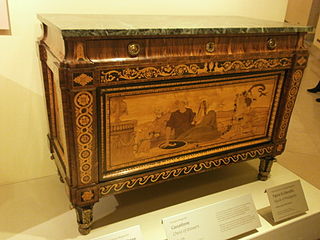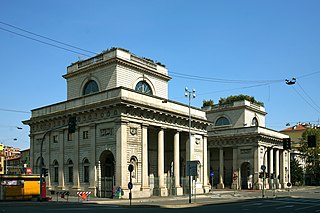
Piazza del Duomo is the main piazza of Milan, Italy. It is named after, and dominated by, the Milan Cathedral. The piazza marks the center of the city, both in a geographic sense and because of its importance from an artistic, cultural, and social point of view. Rectangular in shape, with an overall area of 17,000 m2, the piazza includes some of the most important buildings of Milan, as well some of the most prestigious commercial activities, and it is by far the foremost tourist attraction of the city.

Cassano d'Adda is a town and comune in the Metropolitan City of Milan, Lombardy, Italy, located on the right side of the Adda River. It is on the border of the Metropolitan City of Milan and the province of Bergamo. It is served by Cassano d'Adda railway station.

The Pinacoteca di Brera is the main public gallery for paintings in Milan, Italy. It contains one of the foremost collections of Italian paintings, an outgrowth of the cultural program of the Brera Academy, which shares the site in the Palazzo Brera.

Giuseppe Piermarini was an Italian architect who trained with Luigi Vanvitelli in Rome and designed the Teatro alla Scala in Milan (1776–78), which remains the work by which he is remembered. Indeed, "il Piermarini" serves as an occasional euphemism for the celebrated opera house. Piermarini was appointed professor in the Academy of Fine Arts of Brera, better known as Brera Academy, Milan, when it was formally founded in 1776.

Giuseppe Maggiolini, himself a marquetry-maker (intarsiatore), was the pre-eminent cabinet-maker (ebanista) in Milan in the later 18th century. Though some of his early work is Late Baroque in manner, his name is particularly associated with blocky neoclassical forms veneered with richly detailed marquetry vignettes, often within complicated borders. His workshop's output is somewhat repetitive, making attributions to Maggiolini a temptation. His clientele reached to Austria and Poland.

Giocondo Albertolli was a Swiss-born architect, painter, and sculptor who was active in Italy during the Neoclassical period.

Having been ruled by several countries over the years, Milanese culture is eclectic and borrows elements from other countries, including Austria, Spain and France. Similarities between these places and Milan can be noticed through the language, architecture, cuisine and general culture of these countries. In the 18th century, Austrian rule stimulated much of the city's cultural, political, social and economic life, resulting in the founding of numerous important artistic institutions, as well as contributing to the city's architecture. After the unification of Italy in 1861, Milan became a major industrial and cultural centre in the new Kingdom; in the late 19th century onwards, the city held the position of the country's economic capital, whilst Rome was the seat of the government, making it the country's main political and administrative hub. In the fin-de-siècle period and the early 20th century, the city became an important architectural centre, and remained a prominent city with regard to a major intellectual scene. After World War II, Milan was highly affected by the Italian economic miracle, or il boom, and attracted a wave of immigrants from Southern Italy, who sought work in the prosperous city. By then an important centre for finance and design, the metropolis grew into a major fashion capital in the 1980s. In the 2000s Milan still remains one of the country's most important cultural, media and economic centres, regarded as the nation's second city; its prominence is extended worldwide, and it is recognised as an Alpha global city. The city additionally hosted the Expo 2015. Milan is traditionally referred to as the moral capital of Italy, especially due to the city's perceived work ethic.

The Royal Palace of Milan was the seat of government in the Italian city of Milan for many centuries. Today, it serves as a cultural center and it is home to international art exhibitions. It spans through an area of 7,000 square meters and it regularly hosts modern and contemporary art works and famous collections in cooperation with notable museums and cultural institutions from across the world. More than 1,500 masterpieces are on display annually.

Porta Venezia is one of the historical gates of the city of Milan, Italy. In its present form, the gate dates back to the 19th century; nevertheless, its origins can be traced back to the Medieval and even the Roman walls of the city.

Palazzo Castiglioni is an Art Nouveau palace of Milan, northern Italy. It was designed by Giuseppe Sommaruga in the Liberty style and built between 1901 and 1903. The rusticated blocks of the basement imitate a natural rocky shape, while the rest of the decorations are inspired by 18th century stuccos. The building is now used as the seat of the Unione Commercianti di Milano.

Palazzo Marino is a 16th-century palace located in Piazza della Scala, in the centre of Milan, Italy. It has been Milan's city hall since 9 September 1861. It borders on Piazza San Fedele, Piazza della Scala, Via Case Rotte and Via Tommaso Marino.

Neoclassical architecture in Milan encompasses the main artistic movement from about 1750 to 1850 in this northern Italian city. From the final years of the reign of Maria Theresa of Austria, through the Napoleonic Kingdom of Italy and the European Restoration, Milan was in the forefront of a strong cultural and economic renaissance in which Neoclassicism was the dominant style, creating in Milan some of the most influential works in this style in Italy and across Europe. Notable developments include construction of the Teatro alla Scala, the restyled Royal Palace, and the Brera institutions including the Academy of Fine Arts, the Braidense Library and the Brera Astronomical Observatory. Neoclassicism also led to the development of monumental city gates, new squares and boulevards as well as public gardens and private mansions. Latterly two churches, San Tomaso in Terramara and San Carlo al Corso, were completed in Neoclassical style before the period came to an end in the late 1830s.

The Palazzo Brentani is a historic mansion located in the centre of Milan, Italy, at Via Manzoni number 6. Both this palace and the adjacent Palazzo Anguissola sport Neoclassical facades, designed by Luigi Canonica in 1829.

Leopoldo Pollack was an Austrian-born Italian architect who was active in Milan where he became one of the leading proponents of Neoclassical architecture.

Giuseppe Zanoia (1752–1817) was an Italian Neoclassical architect who is remembered for his Porta Nuova in Milan. He also collaborated on the Neogothic design of Milan's Duomo.

The Palazzo Saporiti, also known as Palazzo Rocca-Saporiti, is a historic Neoclassical mansion in the centre of the north Italian city of Milan.

The Palazzo Tarsis is an 18th-century mansion in Milan, northern Italy, built in the Neoclassical style. Its interiors were fully renovated after the building was bombed in 1943. Historically part of the Porta Nuova district, it is located at 1, Via San Paolo.

The Palazzo Taverna is a late Neoclassical mansion in Milan, Italy, designed by Ferdinando Albertolli in 1835. It is located at 2, Via Montenapoleone, in the Porta Nuova district of the city.

Grazioso Rusca was a Swiss sculptor who was also active in northern Italy.

Giuseppe Franchi was an Italian Neoclassical sculptor.






















